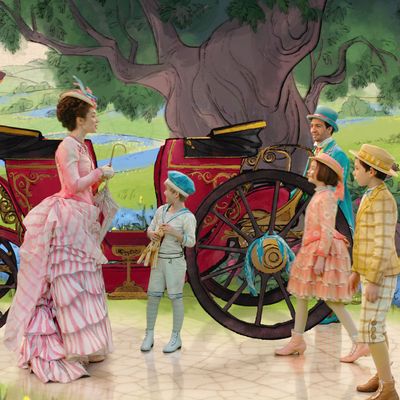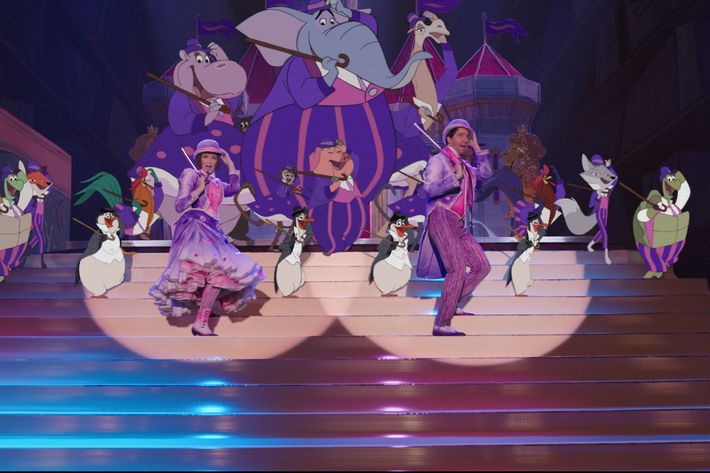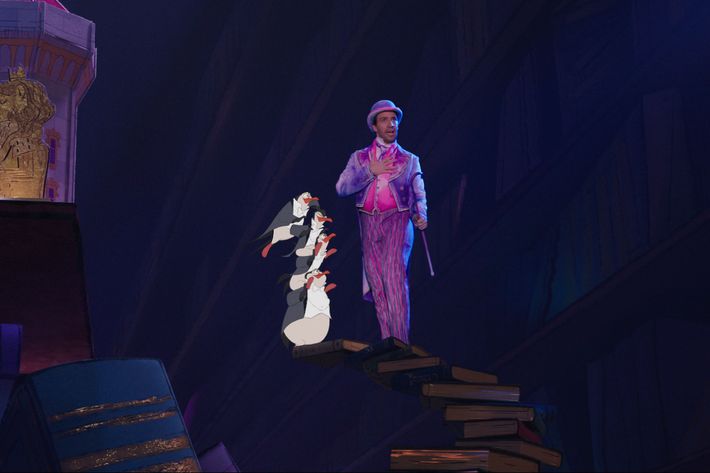
Trouble’s afoot in Old Blighty. Despite specific instructions not to horse around, the rambunctious Banks children have been roughhousing, and they’ve cracked the family’s prized Royal Doulton bowl. Father will positively blow a gasket when he discovers the damage, but luckily, nanny extraordinaire Mary Poppins has a plan to save the day. A few upbeat words, some wishful thinking, and she’s magicked the youngsters into the sunny afternoon scene painted on the side of the container so that they may fix it themselves. Back in the real world beyond Mary Poppins Returns, however, it’s not quite so simple.
For the creative personnel behind Disney’s flashy new sequel, the jaunt through the painterly fantasia of Royal Doulton would prove the production’s most formidable technical challenge — and as director Rob Marshall tells it, “the hardest thing I’ve ever actually done on film.” Speaking with Vulture, Marshall laid out the complicated, labor-intensive process by which the visual-effects team combined live-action, 2-D animation, and 3-D computer rendering to create a passage of eye-popping originality within a repurposing of intellectual property. Whatever a viewer’s criticisms of the film itself, there’s no denying that this sequence represents a stunning synthesis of state-of-the-art technology and old-fashioned artistry. They’ve all but gotten dreaming down to a science.
“There was a lot of expectation on us to not just pay homage to the original movie, but to make it fresh and new and contemporary as well,” explains visual effects supervisor Matt Johnson. “In the 1960s, [SFX godfather] Peter Ellenshaw used the most up-to-date technology available to create their vision of the animated world, so we thought we’d do the same thing.” Marshall, Johnson and their collaborators ran up against the same challenge faced by everyone in the remake-industrial complex, with an audience demanding something at once familiar and novel, the same but not. Over the arduous, year-and-a-half production process, they realized they could split the difference by using innovation for emulation.
So Marshall went right to the source, rounding up stalwarts from the heyday of hand-drawn techniques. “I gathered fabulous animators from Pixar and Walt Disney Animation,” he says, “and we met at the Disney studio in this wonderful bungalow called the Hyperion, which is the bungalow that they actually took from the first Walt Disney Animation studios. It was myself, [writers] John Deluca and David Magee, composers Marc Shaiman and Scott Wittman, our supervising animator Jim Capobianco, and a room full of 20 animators. It was a few of the most exciting, scary days of my life.”
By the time production shifted into full gear, the artists’ number totaled upward of 100. “It was great to combine a literally back-to-the-drawing-board style of animation with artists that had come out of retirement just for this job,” says Johnson. “Walt Disney could’ve walked into the studio and felt very comfortable around everyone using flipbooks and paper.” They took over three floors along with the basement level at the renowned Ken Duncan studio in Pasadena, where Johnson remained hard at work while Marshall continued to crank out new footage back on set. Together, they formed a giant, well-oiled machine with lots of moving parts.
“I was editing the material while I was shooting, and then getting it off to the animators right away, so they could start working on it while we were still shooting,” recalls Marshall. The stage veteran encountered unfamiliar trials of skill as he mounted the most mechanically involved of his career; one day, he’d be talking Lin-Manuel Miranda through visualizing a nonexistent staircase of books, and the next, he’d be coaxing child actors into playing off a tennis ball on a stick as if it was a giraffe. He had to conduct serious conversations about presence and intent with actors hobbling around on kneepads, pretending to be animals.
During the Royal Doulton bowl sequence in particular, Marshall found that the task at hand bore little resemblance to his understanding of how to mount a musical number. “I would shoot one version where Emily Blunt would be dancing as Mary Poppins with our four reference penguin dancers,” says Marshall. “I got some of the best, shortest dancers I could find. We rehearsed that for many, many weeks. Then we would take them out, and Emily would imagine where the penguins would be. Then we would take Emily out, and put the reference dancers in, and shoot it again for the third time. That time, it was helpful for the animators to have these reference dancers, so they would know what stencils to draw.”

Johnson and his fleet of special-effects wizards then got to work layering what he calls the “Silver Age look” over the live-action dailies, and then superimposing CGI onto that. Though both Johnson and Marshall were eager to clarify that each maintained a regular presence on the other’s side of the action. On a production of this scale, there was no room for vanity, and both men had to place their trust in many different experts.
“We’d shoot the green-screens of the cast, and have sort of proxy sets,” says Johnson. “For instance, the music hall was a full-size stage, on a one-to-one scale so that the actor would have something to interact with. That then went to a VFX company in Montreal, and they’d track where the camera’s positioned and place that on a checkable grid. Goes right across the frame, a black-and-white grid on the image, and that’s then sent back to our office. We’d print out each frame and see where everything was in terms of orientation on that checkerboard, and then we’d go in and do the hands-on artwork, which would then be digitized and scanned with the computer.”
The biggest hurdle turned out to be mobility. In 1964, the House of Mouse lacked the proper equipment to move the camera through a live-action scene without revealing the animated elements’ lack of depth. But Marshall’s Steadicam worked with fluid cinematography, rendering the flatness of the Royal Doulton’s cartoon bits within our three dimensions.
Johnson threw out the entire rulebook, both as an artist and a technician: “We created a living style that harmonizes the live-action performance, the cartoon penguins, and the computer-animated stuff. It was hugely complicated to reconcile these disparate elements. 2-D is just that, it exists only in two planes, so integrating it with a third dimension means we always have to keep an eye out for where an object exists, and how it’s existing.”

To tie together the rest of their vision for the Royal Doulton scenes, Marshall and Johnson placed their trust in an expert cadre of industry-best professionals. The director sounds like he’s scrambling through an acceptance speech as he emphatically gives credit to the orchestrators, dance arrangers, composers, book writer, animators, choreographers, VFX techs, production designers, and cinematographer who pooled their estimable talents to bring the scene’s vibrant aesthetic to life. An entire feature-length article could be written about the fascinating costuming methodology alone:
“Our costume designer Sandy Powell wanted to integrate the live-action world into the animated world,” says Marshall. “All of the costumes in that sequence are hand-painted and outlined so that they blend into the animated world. Emily Mortimer has this beautiful full-length skirt that goes to the ground, and it has a series of tiers. But there are no tiers! They were just painted on to look like it. Lin-Manuel is wearing a tie, but there is no tie there. It was just hand-painted on to a shirt, as were the buttons. It’s all hand-painted design.”
Though it may have been conceived as a work of art, the Royal Doulton bowl sequence is something like a skyscraper in its testament to the might of human ingenuity and cooperation. Marshall’s the first to admit that one of his chief virtues as a director is his curatorial instinct, of recognizing brilliance and putting it to work under his organizing eye. Digital breakthroughs may have enabled Mary Poppins Returns to pull off an astonishing daydream, but the force that truly made it go is timeless.
“We learned a lot because we learned from each other,” recounts Marshall. “I learned from the animators. I remember, Lin was doing this one little moment where he had a penguin that was sitting on his cane. And I remember the animator saying that the penguin weighs more than that, that you have to make it look like it’s real. And Lin adjusts, and I realize we’re all occupying the same world.”
He continues: “As far as I can say, this is musical filmmaking at its finest. It’s about everyone working together, all in conjunction to create this one sequence. That’s what musicals are to me — one huge collaboration.”

